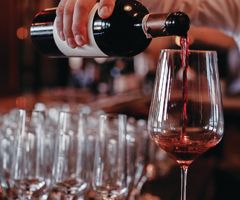Let’s Discover the Art of Wine Making and Exploration
It’s no doubt that wine is more than just a delicious beverage.
It is an art form with a rich history spanning thousands of years. From grape cultivation to fermentation and aging, winemaking is a complex process that balances science and creative flair.
Join us today as we journey from grapes to glass, discovering the artisanship behind one of the world’s most beloved drinks.
Step #1: Selecting the Perfect Grapes
It all begins in the vineyard.
Wine grapes flourish in climates with lots of sun, varying for different types like Cabernet Sauvignon and Pinot Noir. The unique flavors come from factors like soil and elevation, known as terroir. Growers also pick specific rootstocks and clones.
Indeed, growing grapes is both a science and an art. The ripeness is carefully tracked using measurements like Brix levels and acidity.
It’s also crucial to pick the grapes at the right time—too early means underripe taste, and too late loses freshness. Achieving the perfect balance of tannins, sugars, and acids is the key to unlocking peak flavor potential. Timing is everything in the world of grape growing.
Step #2: Crushing and Pressing
Once harvested, winemaking kicks off. Grapes are destemmed to eliminate bitter stems, and crushers delicately release sweet juice.
White wines quickly press for clear juice, while reds soak with skins for color and tannins during fermentation. Innovation, like optical sorting, streamlines crushing. Yet, top wineries often hand-select on vibrating tables, making sure only the finest grapes enhance their wine’s character.
Step #3: Alcoholic Fermentation
Once the grapes are extracted, they undergo fermentation with added yeasts. As yeasts transform grape sugars into alcohol, heat, and carbon dioxide are released.
Red wines usually ferment in stainless steel or enamel-lined tanks, sized for different vineyard yields. White wines often ferment in oak or steel barrels, adding flavors and texture from suspended yeast lees.
During primary fermentation, winemakers carefully regulate temperatures, tracking Brix levels daily. Too cold slows the fermentation process, and too warm can lead to off-flavors.
Step #4: Malolactic Fermentation & Aging
After the first fermentation, many red and some white wines undergo secondary malolactic fermentation, softening acidity and adding buttery or nutty flavors.
Barrel aging enhances complexity through oak interactions. In the cellar, wines evolve, with soft tannins in reds and added richness in whites. Technical steps like racking, fining, and filtering remove impurities. Tastings guide bottling decisions, and master blenders may mix varieties for a balanced complexity.
Step #5: Bottling
Once aging is complete, bottling stops any further changes.
Wines often show the harvest year on the label, while some blend vintages for consistency. Bottled wines settle, allowing sediment to drop before final filtering and packaging. Screwcap closures prevent “cork taint,” and clear bottles offer transparency, while darker ones protect from light damage.
Good news: bottles are recyclable! Foil capsules not only secure the closure but also serve for branding.
Step #6: Terroir and Wine Regions
Beyond the winemaking process, a wine’s character is shaped by terroir and regional styles. Terroir includes factors like soil, topography, and climate. Soils, like chalky ones in Champagne, add distinct flavors.
Italian wines are known for bright acidity, German Rieslings balance tartness with sweetness, and oaked California Chardonnays differ from unoaked white Burgundies. Yup, even neighboring vineyards yield different wines due to microclimates and winemaking choices, making each wine unique.
Step #7: The Art of Tasting
Exploring wines is an art, and tasting them involves a few simple steps.
First, check the color—reds can range from purplish to brick red, while whites go from pale lemon to golden straw. Give the glass a swirl to release aromas, which can tell you about grapes, regions, or aging.
Next, taste and pay attention to how sugars, acids, tannins, and alcohol interact. Is the wine crisp, supple, rich, or bright? Note down your impressions in a notebook—describe aromas, flavors, and how they feel in your mouth.
These notes will build a vivid picture of your wine experiences and help you see how wines change over time.
Step #8: Pairing Wine with Food
Wine and food go hand in hand. Vintage wines elevate special occasions, while affordable ones enhance everyday meals.
Consider the weight, intensity, and origin of the wine when pairing. Light wines suit delicate dishes like seafood, bold ones go with hearty meals. Season matters—chill bright wines for summer, enjoy velvety reds in cooler months. Experiment with pairings to discover what delights your taste buds. The fun is in the discoveries along the way!
Conclusion
Wine spans 9000 years of history, from the Greeks and Romans to today’s global vineyards.
As we raise a glass to this rich history of wines, we extend a warm invitation for you to immerse yourself in the experience at Dario’s Steakhouse and Seafood. Each sip at Dario’s is a toast to the centuries of craftsmanship, innovation, and tradition that have shaped the world of wine. Cheers to the timeless allure of wine!

